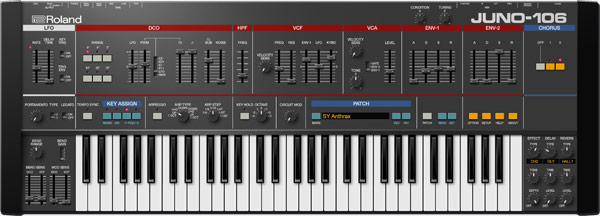

Chorus has a peculiar vintage color inherent in the guitar pedals of that period. See 26 musician reviews, how 283 pros use it, 10 candid photos, and where to get a. Juno-106 offers a built-in analog stereo chorus, based on BBD technology with two types of sound. Now 1350.00 (updated 29 minutes ago): Roland Juno-106, Synthesizers. DCO, VCF, LFO parameters can be controlled with a bender. The LFO features frequency and depth control. There is also a non-resonant Hi Pass Filter. The excellent LowPass Filter is worth mentioning - it's analog, it has a slope of 24dB/oct with resonance control, it's possible to modulate the LFO (built-in low-frequency oscillator) or envelope to get those wobbles and quacks.

Fortunately, this can be cured! There are modern clones 80017A (for example AR80017A). These boards were covered with a black-colored thermoactive polymeric resin, and considering that this material ceases to be a dielectric (it starts to be conductive), the modules simply burn out and the synthesizer loses its voices. DCO modules are located on separate boards soldered to the main board at a 90-degree angle. Everything is right in front of you on the front panel and all you have to do is start fiddling with the. Like the Juno-60, the Juno-106 is incredibly easy to use and is a great tool for anyone interested in learning about programming synthesizers.
#JUNO 106 PATCH#
And here Roland Corporation made a mistake, or a miscalculation (after all, no one knew how long Juno-106 would be in demand). The Juno 106 also increased the memory to 128 patches from the 56 patch memory in the Juno-60. This method made it possible to eliminate the pitch drift inherent in analog synthesizers.

The core of the synthesizer comprises six DCOs (Digitally Controlled Oscillators): these are analog modules controlled by a microcontroller - Roland 80017A.
#JUNO 106 SOFTWARE#
The JUNO-106 Software Synthesizer perfectly realises the influential sound and vibe of. This synthesizer can be heard in albums recorded by: Rolands famous JUNO synth sounds, now available as a DAW plug-in. This synthesizer supports MIDI control and responds to SysEx commands - it allows editing and uploading presets via computer (VST-AU JUNO-106 Editor by rekon, Juno 106 Editor by Benjamin Jaeger, etc.). Though unlike its ancestors, it features 128 presets that can be saved and offer a quick switch between them – that might have determined its popularity. Juno-106 is Juno-6 and Juno-60 successor.


 0 kommentar(er)
0 kommentar(er)
